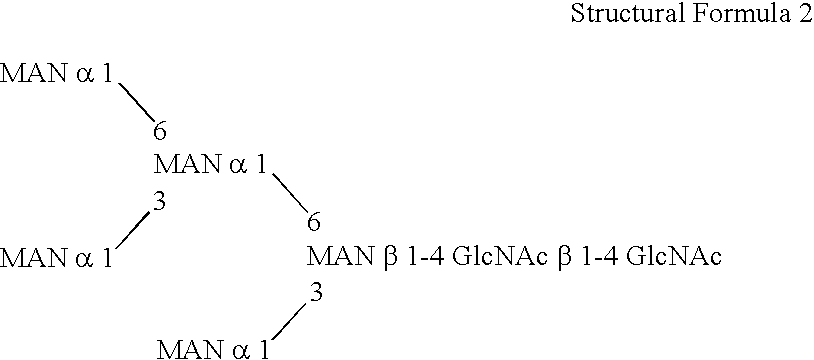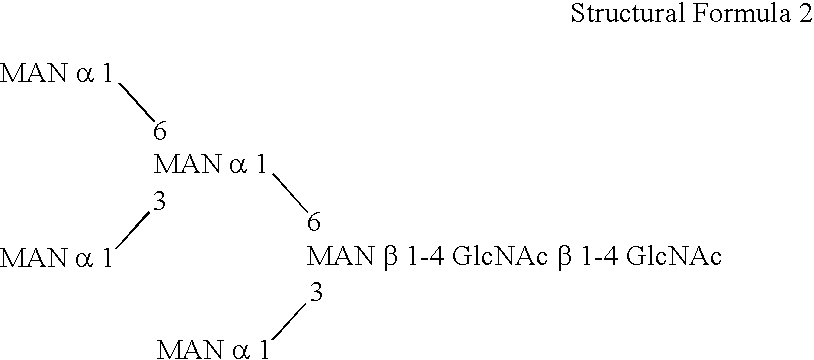Methylotroph producing mammalian type sugar chain
a technology of methylotrophs and sugar chains, applied in the direction of transferases, lyases, applications, etc., can solve the problems of short retention time in the body, low Cerevisiae /i>, and the inability of microorganisms to attach sugar chains with the same structure as human glycoproteins
- Summary
- Abstract
- Description
- Claims
- Application Information
AI Technical Summary
Benefits of technology
Problems solved by technology
Method used
Image
Examples
example 1
Selection of Methylotrophic Yeast Suitable for Production of Mammalian Type Sugar Chain
[0300] To obtain a mammalian type sugar chain producing yeast using methylotrophic yeast, it is necessary to clone and inactivate a sugar chain synthesizing gene peculiar to the methylotrophic yeast. The sugar chain structure differs largely with the type of the yeast, as described above. In other words, the enzyme and gene involved in the biosynthesis of sugar chain also differ depending on the type of the yeast. Accordingly, when intending to disrupt the gene involved in the biosynthesis of sugar chain to remove the sugar chain peculiar to the yeast, the first thing to do is to isolate the gene. As such isolation, however, requires a large number of steps, we decided to select a methylotrophic yeast, which requires the smallest possible number of isolation steps. The selection of strains suitable for the isolation was made using NMR data on the cell wall of yeast as an indication of selection ...
example 2
Cloning of Glyceraldehyde-3-Phosphate Dehydrogenase (GAP) Gene of Ogataea minuta
[0314] The GAP gene was obtained from Ogataea minuta IFO 10746 and its nucleotide sequence was determined.
(2-1) Preparation of Probe
[0315] Oligonucleotides comprising nucleotide sequences corresponding to the following amino acid sequences conserved in glyceraldehyde-3-phosphate dehydrogenases from Saccharomyces cerevisiae (GenBank accession number; P00359) and from Pichia pastoris (GenBank accession number; Q92263):
AYMFKYDSTHG;(SEQ ID NO: 1)andDGPSHKDWRGG(SEQ ID NO: 2)
[0316] were synthesized as follows.
(SEQ ID NO: 3)PGP5;5′-GCNTAYATGTTYAARTAYGAYWSNACNCAYGG-3′(SEQ ID NO: 4)PGP3;5′-CCNCCNCKCCARTCYTTRTGNSWNGGNCCRTC-3′
[0317] The primer PGP5 has a sequence complementary to the nucleotide sequence corresponding to the amino acid sequence AYMFKYDSTHG, and the primer PGP3 has a sequence complementary to the nucleotide sequence corresponding to the amino acid sequence DGPSHKDWRGG.
[0318] Chromosomal DNA...
example 3
Construction of Expression Cassette Using GAP Gene Promoter and Terminator
[0324] An expression cassette for transferring foreign genes was constructed between the GAP gene promoter (SEQ ID NO:7) and terminator (SEQ ID NO: 8) of Ogataea minuta. A 3.2-kb HindIII-BamHI fragment was isolated from pOMGP1 described in Example 2-2 and inserted into the HindIII-BamHI of pBluscript II SK−. The obtained plasmid was named pOMGP2 (FIG. 5). A 3-kb HindIII-KpnI fragment was isolated from the pOMGP2 and the EcoRI site was inserted into the HindIII-KpnI of blunt-ended pUC19. The resultant plasmid was named pOMGP3 (FIG. 5). To transfer SalI and EcoT22I sites between the GAP gene promoter and terminator, the primers:
5′-GTTTGAATTCACTCAATTAACATACACAAATACAATACAAAGTCGACAAAAA(SEQ ID NO: 9)ATGCATGTGGATAGATGACCAATGGCCTCTTTAAGTAAACATTTCGTTTTGAATATATTTC-3′,and 5′-TTTTTACTAGTACGGTACCGCTCGAATCGACACAGGAG-3′(SEQ ID NO: 10)
were synthesized. These primers were used to carry out PCR using the pOMGP2 as a templ...
PUM
| Property | Measurement | Unit |
|---|---|---|
| temperature | aaaaa | aaaaa |
| temperature | aaaaa | aaaaa |
| time | aaaaa | aaaaa |
Abstract
Description
Claims
Application Information
 Login to View More
Login to View More - R&D
- Intellectual Property
- Life Sciences
- Materials
- Tech Scout
- Unparalleled Data Quality
- Higher Quality Content
- 60% Fewer Hallucinations
Browse by: Latest US Patents, China's latest patents, Technical Efficacy Thesaurus, Application Domain, Technology Topic, Popular Technical Reports.
© 2025 PatSnap. All rights reserved.Legal|Privacy policy|Modern Slavery Act Transparency Statement|Sitemap|About US| Contact US: help@patsnap.com



